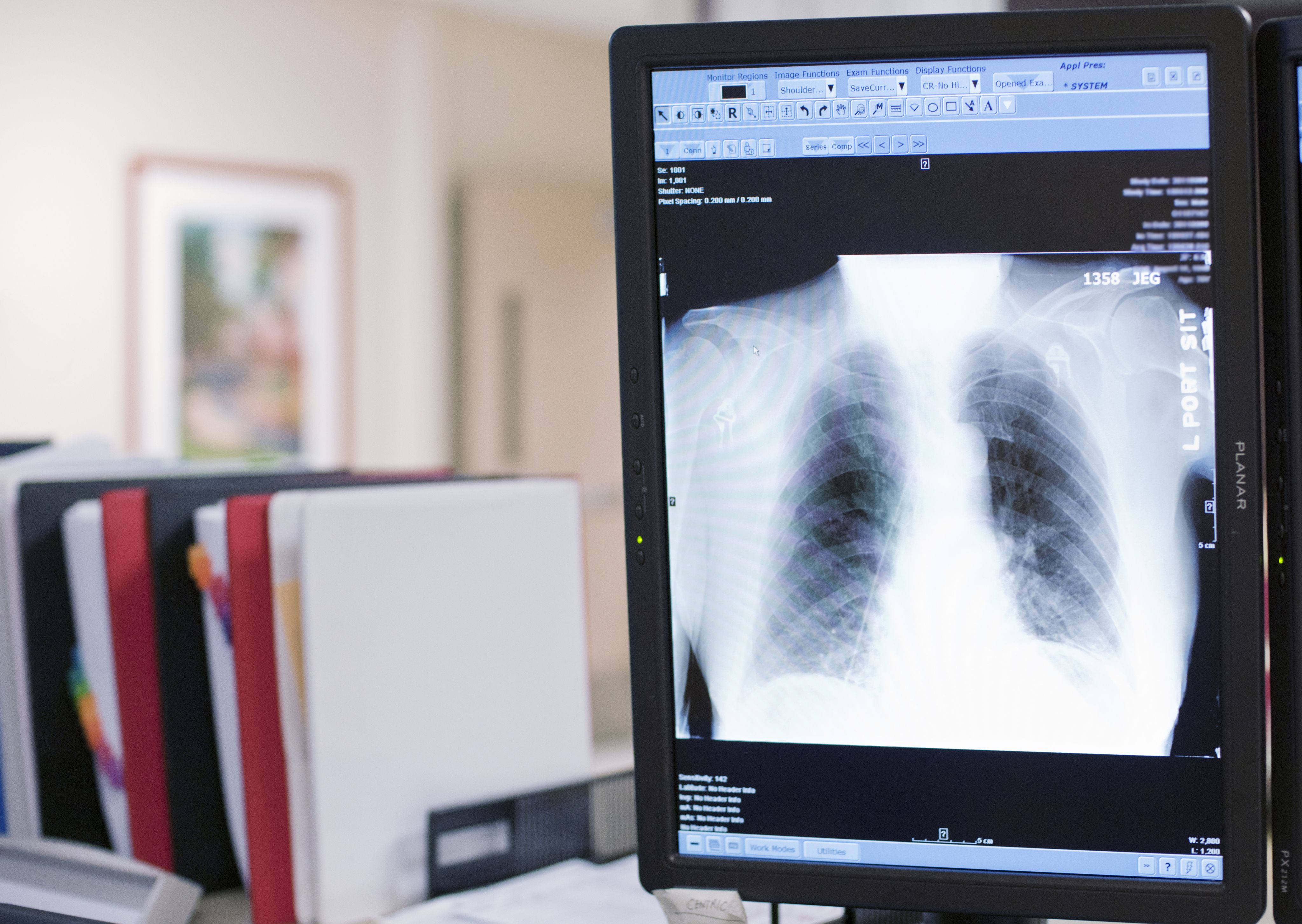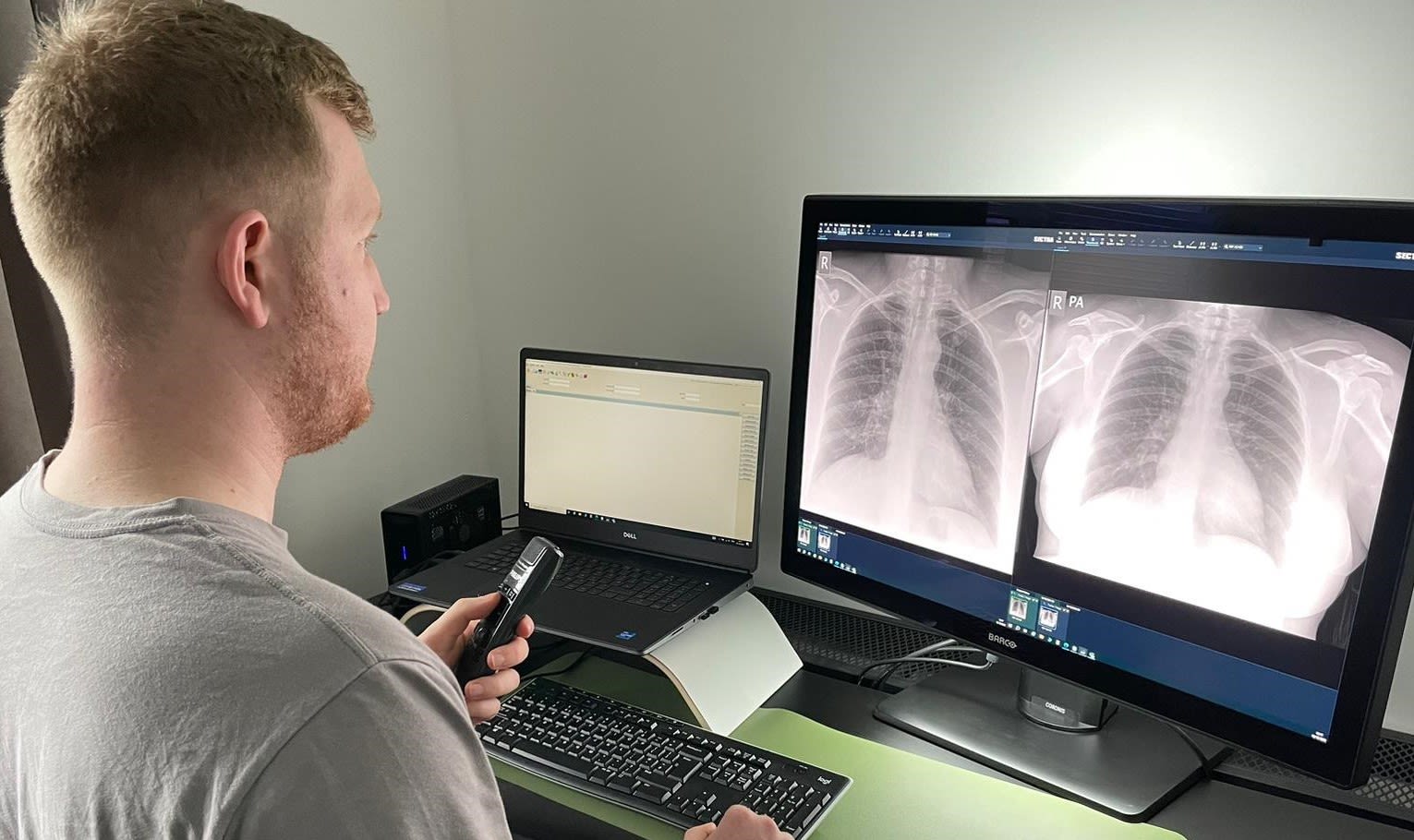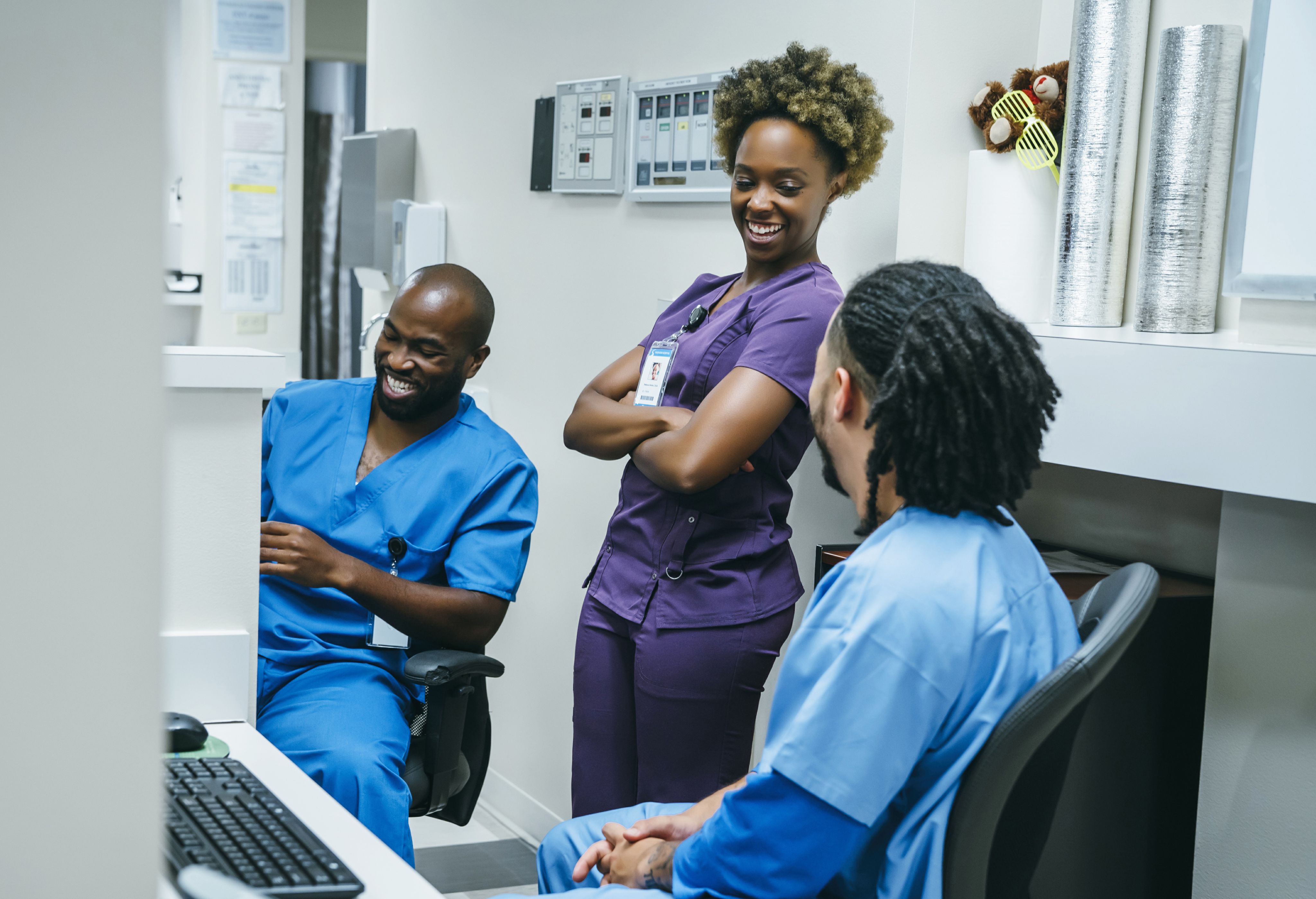
Radiography at home
At-home reporting for radiographers is now more practical than ever before – but questions still remain over the benefits of the practice
At the onset of the Covid pandemic, radiography departments in the UK faced a sudden and extreme shift in operations: the three UK cancer screening programmes for breast, bowel and cervical cancer were temporarily suspended, with invitations and follow-up appointments delayed; diagnostic radiography was restructured to facilitate care as demand for medical imaging shifted, all while trying to reduce non-essential contact between patients and staff in an attempt to slow the spread of coronavirus.
Away from the health service, most people were forced to work from home where they could, in order to slow the spread of the virus, but in the health services, home-working was a much more complicated endeavour.
Reporting radiographer was one of the few roles that could effectively be carried out at home, but how has at-home reporting developed since the initial pandemic activity?
What is at-home reporting?
Reporting radiographers play an important role in any clinical environment, working to document and report imaging results on behalf of the radiography team. This includes providing definitive clinical reports with diagnosis of injuries and pathologies demonstrated on imaging, as well as communicating with members of the healthcare team.
Reporting radiographers provide definitive reports for a range of different imaging modalities and patient pathways dependent on local service need.
Throughout their clinical work and while working from home, reporting radiographers use diagnostic display workstations, which must be high resolution, high luminance, and fast loading for displaying large image datasets.
Reporting at home
The ability to work from home was not available to every profession in the UK, and for much of the health service this held true. However, an option for some reporting radiographers to install reporting stations inside their homes changed the way some departments worked.
This flexibility helped speed up the diagnostic process.
Home reporting allowed for shielding and self-isolating colleagues to contribute to the workload, and facilitated social distancing on-site.
In the wake of this shift, opinions surrounding the return to clinical settings for reporting radiographers are split – should at-home reporting become a staple of radiography practice, or should site-based reporting be encouraged?
Why it works
Working from home can allow reporting radiographers increased reporting capacity, flexibility for hospitals, and a better work-life balance for overstretched workers, the Royal College of Radiologists (RCR) found in its home reporting advisory document.
This would particularly benefit those with carer responsibilities and those close to retirement, helping to reduce extended commutes and potential fatigue.
Burnout as a consequence of the pressures of the profession could also be reduced – helping to ease the stress of the job and keeping more radiographers in the profession.
Niall Rowlands, diagnostic radiographer at Wrightington, Wigan and Leigh (WWL) Teaching Hospitals NHS Foundation Trust, explained as much to Synergy, adding that the pandemic acted as a catalyst in the introduction of remote working.
Initially, consultant radiologists were encouraged to work from home, then as more resources became available, the home workstations were rolled out to the reporting radiographers.
Niall said: “It was agreed that we would be approximately 20 per cent more productive when working from home, considering different examinations/referral sources. Improved productivity has obvious benefits for our patients: a timelier diagnosis and prompt onward referral, where necessary, ultimately improves the patient journey.
“Secondly, the home workstations provide a more cost-effective alternative when dealing with exams which may have historically been outsourced. Home working also allows us as a team to provide an out of hours plain X-ray reporting service over extended Bank Holidays such as Christmas and Easter and could, in the future, be utilised in a seven-day service.
“Home working for reporting radiographers is still not commonplace within the NHS, and it is a useful recruitment and retention tool for us at WWL. An improved work life balance, and less time travelling to work, can appeal to many.”
Niall Rowlands, diagnostic radiographer at Wrightington, Wigan and Leigh Teaching Hospitals NHS Foundation Trust

Niall Rowlands, diagnostic radiographer at Wrightington, Wigan and Leigh Teaching Hospitals NHS Foundation Trust
Niall Rowlands, diagnostic radiographer at Wrightington, Wigan and Leigh Teaching Hospitals NHS Foundation Trust
A balancing act
Niall added that while potential negatives shouldn't be disregarded, it was a “relatively simple process” to identify and overcome these issues.
Reduced interaction with colleagues, for example, would prevent radiographers discussing interesting cases or asking a radiologist’s opinion on a difficult exam. Niall’s team overcame this by ensuring a minimum number of radiographers are working on site to support trainee radiographers, and radiology registrars and other staff.
“I have been working from home one day a week for just over 12 months,” said Niall. “The installation was seamless and, within 10 minutes of the workstation being installed, I was reporting. The network speed is similar to working on site with images taking seconds to load on screen. Since working from home one day a week my own personal job satisfaction has increased.
“We work from home one day a week and the rest of the time we report on site. Whilst I think there could be an opportunity to increase the number of days, it is a delicate balancing act as we need to make sure we have an on-site presence and there is no replacement for face-to-face discussions around interesting cases or imaging techniques.
“It would be great to work from home more and make greater use of our equipment and further increase our productivity. My personal preference would be to have a 50/50 split of working from home and working on site. For me that would be two days at home and two days on site. I think this would allow us to maximise the advantages of home reporting whilst negating any potential drawbacks.”
Supporting colleagues
Marie Gibson, lead reporting radiographer for the University Hospital of Leicester (UHL), agreed with Niall.
Marie told Synergy that reporting from home had been an important development for the reporting radiographer service, but that it was important to consider the experience level of reporting radiographers, the ratio of home to site-based reporting, and the level of support a trust was able to provide.
At UHL, home reporting was offered to a small cohort of experienced radiographers, and was structured to allow time both for “focused” reporting and for supervising trainee radiographers and specialist radiology trainees.
According to Marie, the lower levels of interruption at home allowed for an increase of 25 per cent in allocated reporting workloads, and radiographers said they were more likely to volunteer for additional reporting sessions outside of core working hours as they were able to work around home commitments.
“Reporting radiographers with home working included within job plans enjoy being more focused and productive due to reduced interruptions, as well as being able to use their usual commute time or lunch break to exercise or catch up with household chores,” she said.
“The inclusion of reporting radiographers in the roll out of home reporting has had a positive impact on the reporting service. The increased capacity provided has reduced reliance on external providers and improved reporting turnaround times. The value of flexible working and its impact on staff well-being is equally important and it is likely that more reporting radiographers will be offered home reporting within job plans in the future.”
Marie Gibson, Lead reporting radiographer, UHL
Marie Gibson, Lead reporting radiographer, UHL
Steve Leatherland, Regional director for distributor Hospital Services Limited
Steve Leatherland, Regional director for distributor Hospital Services Limited
Emerging technology
Additionally, new technology has made the practice more feasible than ever, according to Steve Leatherland, regional director of operations at medical supply distributor Hospital Services Limited, and the option could help alleviate the staffing shortage crisis facing the NHS.
Steve said: “In a career landscape where work from home remains a popular option for employees, giving reporting radiographers the ability to adopt a hybrid working arrangement can contribute to increased job satisfaction and ultimately contribute to staff retention in a field where candidates are in high demand and short supply.
“Not only will staff appreciate the ability to work from home for a better work-life balance, trusts have also commented on increased output in reporting from at-home reporting radiographers, which can be attributed to fewer workspace distractions than a busy clinical environment.”
Steve emphasised hospitals should seek out systems that “work in synergy” with hospital setups, not only for the look and feel of the interface but for integration with patient records to smooth information transfer.
He added: “With backlogs continuing to grow, this could deliver true value for patients who are awaiting results and reports to determine treatment plans.”
Bespoke designs
Lewis Murphy, a chest X-ray reporting radiographer from the Newcastle Upon Tyne Hospitals NHS Foundation Trust, told Synergy that, given the the recruitment and retention crisis radiology departments were currently facing, departments “cannot ignore the spectre of private providers competing with our departments for experienced staff – the seemingly generous rates of pay and casual work schedules are undoubtedly attractive to some.”
He urged managers to engage with team members and permit variation in schedules, as “bespoke designs” enabled his own trust to retain staff who had been due to retire, as well as increasing the working hours of part-time colleagues, while reducing outsourced spending by offering home reporting to colleagues whose commute would usually prohibit weekend or evening overtime.
Marie Gibson echoed this sentiment, explaining that “despite being able to connect virtually using Microsoft Teams, home working is still often described as lonely. Therefore, a balance of home and on site working is preferred by the team to enjoy time with colleagues and benefit from professional discussions.”
NHS England (NHSE) has also noted there is “very little” evidence around the use of home reporting, but that it appears to “anecdotally” increase reporting output.
The drawbacks
However, many hospitals are considering the potential challenges regarding quality and accuracy of reporting.
The role of employees in any radiology department “extends far beyond issuing reports for radiology investigations – any department implementing homeworking must ensure that these other roles remain fulfilled”, the RCR said in its advisory report.
In particular: “This requires high-quality video-conferencing and good quality IT support, backed up by the ability to come on-site if the service demands this.”
Tracy O'Regan, SoR professional officer for imaging and research, also emphasised that individual circumstances pose different challenges and advantages. Teams should “review their situations regularly and chat to their teams frequently about any challenges posed and support needed”, she added.
She said: “Definitive long-term research, to provide analysis of costs, effects on staff wellbeing, retention, and patient experience and outcomes is required for a considered evidence base to practise.”
Dr Tracy O’Regan, SoR professional officer for imaging and research
Dr Tracy O’Regan, SoR professional officer for imaging and research
Alex Peck, Chair of SoR’s Radiographic Informatics Advisory Group
Alex Peck, Chair of SoR’s Radiographic Informatics Advisory Group
Practicality and reality
Alex Peck, chair of the Society of Radiographers’ Radiographic Informatics Advisory Group, pointed out however that while allowing the option of at-home reporting would be ideal, this isn’t always possible.
“Some people just don’t have the space,” he told Synergy. “They need to have a lockable space so they can secure the equipment and protect patient details. You also need to think about the environment you’re using [reporting monitors] in – if they’re in the wrong environment, you get the wrong reflections, so if they’re not quality assured, they could be useless.”
Alex added that the feasibility of at-home reporting would depend on the capacity and resources available to the individual trust.
He also warned that if radiographers chose to work from home exclusively, “effectively, their jobs could be outsourced to another country.”
Steve Leatherland also told Synergy that concerns had been raised around the maintenance and update of at-home reporting stations, which is required to keep the technology at its optimal level. Moreover, at-home reporting solutions must “integrate seamlessly” with the hospital or trust’s workflow to keep sensitive data protected, and to prevent unnecessary work being added.
Outstanding quality display, easy-to-use interfaces, and reliability are all significant factors for at-home reporting stations.
The need for continuous accuracy testing, calibration, and update installation all present challenges, Steve acknowledged. However, the potential benefits of enabling work from home should not be underestimated, he added.
Staff choice
But even if trusts had the capability for all reporting radiographers to work from home, would they want to?
Lewis Murphy said that the opportunity to learn directly from clinical leadership was a vital aspect of being in the office.
From assisting newly qualified radiographers with difficult patients and supervising trainees to discussing cases with referrers and reassuring patients worried about their requests – in Lewis’ view, “face to face interaction is essential.”
“We should not isolate or undermine ourselves by being too keen to do our jobs from home,” Lewis added. “We need to remember the wealth of knowledge and experience our radiologist and reporting radiographer colleagues possess. This is significantly more accessible when working together in the same department, whilst vital to enhance our reports and provide reassurance.”
However, homeworking cannot replace the physical presence in the radiology department required to fulfil the multifaceted leadership and training roles.
Alex added: “We will walk down the corridor to find someone. I think it's very different to try and find someone on video call and then summon them than to just walk down the corridor.
“Radiographers reporting are part of a team. They'll get into a discussion about the process while the imaging is live. I think the biggest recruitment retention phase is going to be the reporting radiographers floating around the hospital, effectively teaching the next generation because that's where the next big batch of people are going to come from.”
Tracy O’Regan added that “leadership can be much more difficult when you're not in the same location as the team.”

A consensus?
Individual circumstances will tend to dictate the feasibility of working from home.
For those in unique positions of care, or who need to reduce their commute and the potential fatigue associated with extended travel, at-home reporting provides an effective and promising solution to address the workforce crisis which currently afflicts the NHS.
But leadership, on-the-job learning, and the opportunity to collaborate and aid colleagues in the many aspects of radiography simply cannot be replicated by the experience of working from home.
And while more thorough research is needed on the clinical outcomes of at-home reporting, it is also clear that increased flexibility may help combat the widespread staffing issues facing the radiography profession.
Find out more...
The SoR's Radiographic Informatics Group (RIG) covers a range of areas which employ IT for clinical imaging and therapeutic radiography services, including the generation, handling, communication, storage, retrieval, management, analysis and synthesis of data and knowledge. The purpose of RIG is to enable the Society of Radiographers to keep up to date with and influence developments, and to support and advise SoR members in dealing with informatics issues.
The aim of the Radiographic Informatics Group is to assist radiographers, managers and education providers to embed IM&T into everyday practice.
Image credits: Reza Estakhrian/ The Image Bank/ Getty Images
FS Productions/Tetra Images/ Getty Images
Now read...






